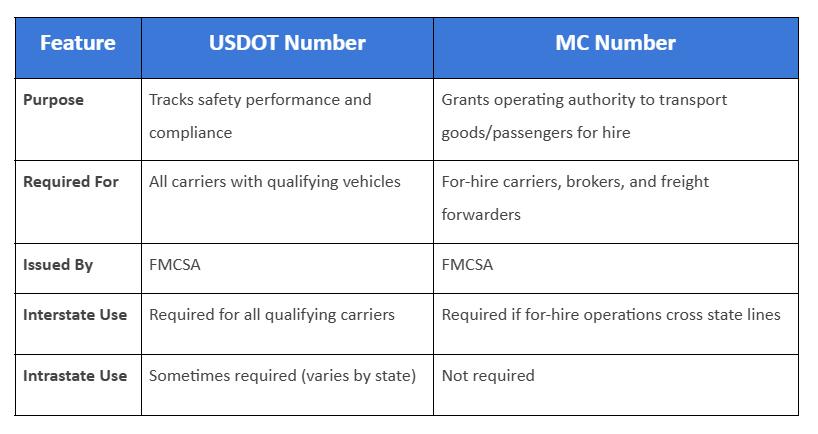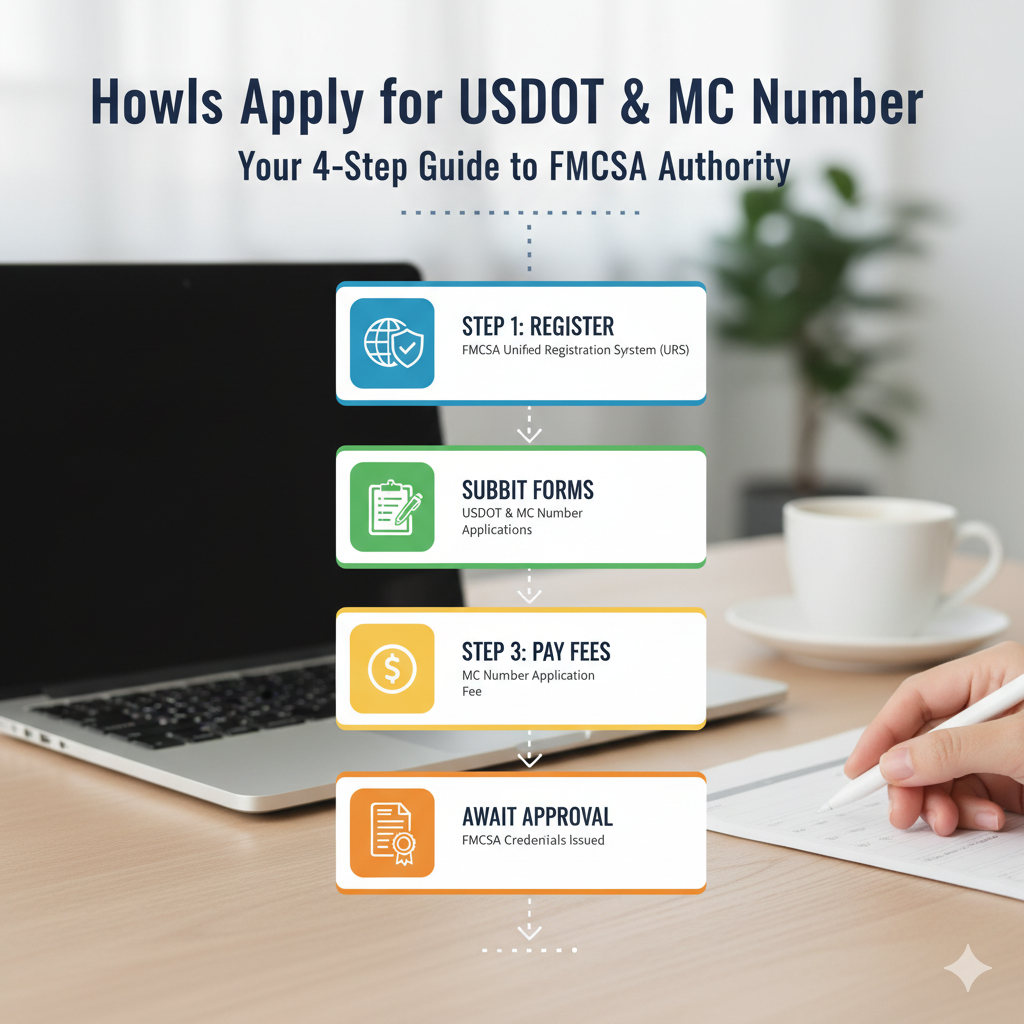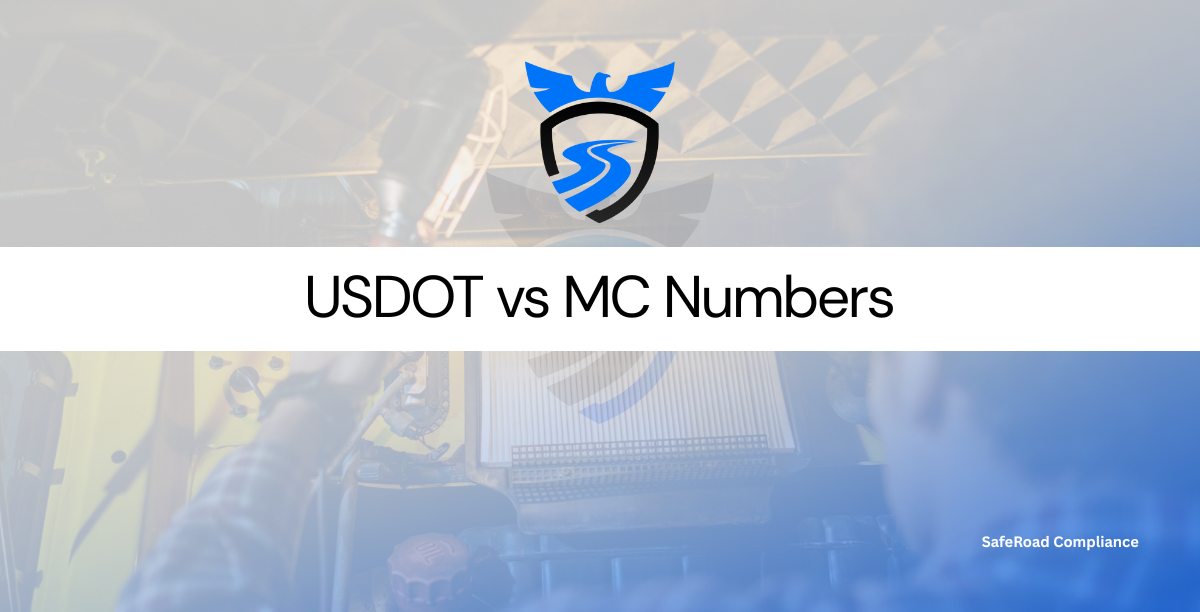Introduction: Why USDOT and MC Numbers Matter for Motor Carriers
Starting a trucking or transportation business in the United States means entering one of the most regulated industries. The Federal Motor Carrier Safety Administration (FMCSA) plays a central role in ensuring that motor carriers operate safely and within federal law. Two of the first compliance requirements every carrier encounters are the USDOT Number and the MC Number.
At first glance, they might look similar, but in reality, they serve very different purposes. A USDOT Number allows the FMCSA to monitor a company’s safety performance, while an MC Number establishes the carrier’s operating authority in interstate commerce. For trucking companies, brokers, and passenger carriers, knowing which numbers you need, and why, isn’t optional. Failure to comply can lead to costly fines, out-of-service orders, and even failed DOT audits that can put your business at risk. By understanding how USDOT and MC Numbers differ, you’ll be able to operate legally, protect your company from penalties, and build a compliant foundation for long-term success.
What is a USDOT Number?
A USDOT Number is essentially the “fingerprint” of your trucking company in the FMCSA’s database. Think of it as an identification number that connects your company to its safety history, compliance records, and inspections. Every time your vehicle undergoes a roadside inspection, crash report, or compliance review, that information is tied back to your USDOT Number.
You are required to obtain a USDOT Number if your commercial vehicles:
- Operate in interstate commerce (cross state lines for business purposes)
- Transport passengers or haul cargo in commerce
- Have a gross vehicle weight rating (GVWR) or combined weight rating of 10,001 pounds or more
- Transport hazardous materials in amounts requiring placarding under federal regulations
For example, if you run a small fleet of box trucks delivering freight across state lines, you will absolutely need a USDOT Number. Even if you are not hauling for hire, the requirement applies as long as you meet the weight or hazardous materials thresholds.
What is an MC Number?
While the USDOT Number focuses on safety tracking, the MC Number (Motor Carrier Operating Authority) defines the type of transportation services you are legally allowed to provide. If you’re operating “for hire”, that is, transporting goods or passengers for compensation, you will likely need an MC Number in addition to your USDOT registration.
An MC Number is required if your company:
- Transports regulated commodities or passengers across state lines
- Operates as a for-hire carrier, meaning you’re paid to transport someone else’s freight or passengers
- Functions as a broker or freight forwarder, arranging transportation for others
In other words, if your trucking business crosses state lines and gets paid to move freight, an MC Number isn’t optional, it’s mandatory. Without it, you’re operating without proper authority, which can trigger penalties, shutdown orders, and major problems during a DOT audit.
Key Differences Between USDOT vs MC Numbers
Although they’re often applied for at the same time through FMCSA’s Unified Registration System (URS), the USDOT and MC Numbers serve distinct purposes. Below is a quick comparison:

This breakdown highlights the complementary roles of the two identifiers: one ensures safety oversight, while the other regulates your operating authority.
Do You Need Both USDOT and MC Numbers?
In many cases, yes. Most trucking companies that operate across state lines and haul goods for hire need both identifiers. Here’s an example:
- A carrier operating a truck over 10,001 lbs that delivers goods between Texas and Oklahoma must have a USDOT Number for safety tracking.
- If that same company is getting paid to transport goods for another business, it must also obtain an MC Number to establish operating authority.
This is why so many motor carriers apply for both numbers during their initial FMCSA registration. Having the correct credentials from the start prevents delays, compliance issues, and disruptions in business operations.
How to Apply for a USDOT and MC Number

- Register with FMCSA through the Unified Registration System (URS).
- Submit application forms for USDOT and MC Numbers.
- Pay the application fee (only for MC Number).
- Wait for FMCSA approval and issuance of credentials.
Conclusion:
Navigating the world of federal trucking regulations can feel overwhelming, but understanding the core difference between a USDOT Number and an MC Number is the first critical step toward keeping your business on the right side of the law. Think of your USDOT Number as your company’s safety ID, it’s how the government tracks your performance. On the other hand, an MC Number is your legal license to operate “for hire” across state lines. In most cases, if you’re getting paid to haul freight, you’ll need both to stay compliant.
Getting these credentials right from the start isn’t just a formality; it’s a way to protect your livelihood. It helps you avoid expensive fines and sudden out-of-service orders, setting your business on a solid, compliant path. Whether you tackle the application process yourself or work with a trusted DOT compliance service to guide you, investing the time to get it right will secure your business’s future and help you build a reputable, successful operation for years to come.
FAQs
A USDOT Number tracks safety compliance, while an MC Number provides authority to operate as a for-hire carrier or broker.
Yes, if you operate across state lines with qualifying vehicles and transport goods or passengers for hire.
You can apply for a USDOT Number through the FMCSA Unified Registration System (URS) online. The process requires company details, business structure, and type of operations.
To get an MC Number, you must file with the FMCSA, pay a $300 application fee, and provide proof of insurance and a BOC-3 filing. This process can be complex, so many carriers work with compliance experts.
The USDOT Number is free, but the MC Number has a $300 FMCSA application fee.
A USDOT Number is issued almost immediately after online registration, while an MC Number typically takes 20–25 business days for FMCSA processing.
Yes, but only if you’re not for-hire and transporting your own cargo or passengers. If you are for-hire, you must also have an MC Number.
Yes, if you are an intrastate carrier or a private carrier transporting your own goods across state lines, you may not need an MC Number. However, if you haul freight for hire, both may be required.
Operating without proper registration can result in FMCSA fines, out-of-service orders, and penalties that could shut down your business.
You can manage the application directly through FMCSA, but dot compliance consultants can save time, reduce errors, and ensure proper filings.

